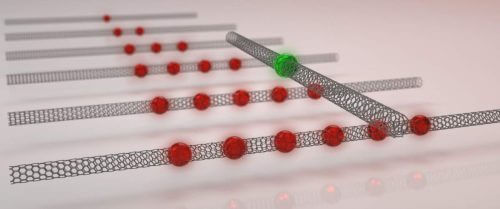Weizmann Institute of Science scientists developed an innovative experimental and measurement system that allowed them, for the first time, to measure and show the existence of a "quantum solid": an organized and orderly structure of electrons, hidden inside a solid crystal made up of atoms

Simulation of the experiment in which the first images of a quantum electronic crystal were obtained, the existence of which was predicted 80 years ago. The researchers saw electrons arranged as pearls in a string (red balls) along a nanowire. To observe the electrons without affecting them, a single electron (in green) carried by another nanowire was used as a sensor (scanning detector) that detected the electric fields created by the electrons in the crystal
Can electrons, like atoms, be organized in a gaseous state of aggregation, or as a liquid, and also as an ordered, solid crystal? This is a question that was first raised by Eugene Wigner, winner of the Nobel Prize in Physics in 1963, and which has been open for about 80 years. Electrons are quantum particles that are in several places at the same time. They also have a very small mass, which means that they are constantly "running around", that is, they have high kinetic energy. Due to these two properties, many scientists doubted the ability of electrons to have significant interactions (interaction) between them, which are necessary for organizing in an orderly and permanent structure, in a kind of "quantum solid".
Many scientists, in different parts of the world, have tried for years to measure, distinguish and identify such a structure of electrons, in one or another block of material - but they were unable to do so. This was the state of affairs until Prof. Shachal Ilani and research students Ilanit Shapir and Assaf Hamo, from the Department of Condensed Matter Physics at the Weizmann Institute of Science, developed an innovative experimental and measurement system - which allowed them, for the first time, to measure and demonstrate the existence of a "quantum solid": an organized and orderly structure of electrons, hidden inside a solid crystal made up of atoms. This initial measurement is described in an article recently published in the scientific journal Science.
Electrons are quantum particles that are in several places at the same time. They also have very little mass, which means that they are constantly 'running around'. Due to these two properties, many scientists doubted their ability to maintain significant interactions between them, which are necessary for organizing in an orderly and permanent structure, in a kind of 'quantum solid'"
The quantum properties of electrons make it very difficult for those who want to measure and map them (since, as we know, in the quantum world "the observer affects the result"). How, then, is it possible to measure and map the positions of the electrons found in one or another sample of material?
To face this challenge, Prof. Ilani and his group members developed the most sensitive electric field sensor in the world - capable of sensing and identifying the electric field of a single electron. This original sensor is built from a nanowire, which "floats" above the sample of the material being measured, and senses the tiny electric fields of the electrons present in it.
Also the sample of the material measured in the experiment was, in fact, a nanowire whose electrons were organized along its length at equal intervals ("like birds on a wire"). The original combination of a sample of a tested material, which is a nanowire, and a particularly sensitive sensor, which is also made of a nanowire, made it possible, for the first time, to distinguish - through the constant "quantum dance" of the electrons, and ignoring the frenzy in which they are subjected due to their small mass - in an orderly structure of electrons, that is, in a solid of electrons embedded in the mapped material.
The electric repulsion force acting between two electrons and responsible for creating the observed quantum crystal phase is about 1 femto-newton - 0.000000000000001 newton
#Science_Numbers
Tags:
Shachel Ilani, physics of condensed matter, quantum physics, electrons, nanowires

6 תגובות
Who will build an Einstein and look at the experiment and not say to the Norwegian scientists: God does not play with dice.
Let these special wires be inserted into the body of people with disabilities or amputees, into the existing nerves, and it is possible to operate robotic prostheses or similar things. (Here's a start-up) because the wires are thinner than the nerves
So what is the nanowire made of?
Well done, they still claim that the education in Israel is inferior. It's nice that you were able to prove a theory, and not influence as spectators. Go up and succeed
noisy What materials are the nanowires from?
The force of repulsion between two electrons certainly depends on their distance. The distance is not given in the article. (last line of the article).
But I will sleep well tonight even without knowing the distance.
Have a good week everyone
Yehuda